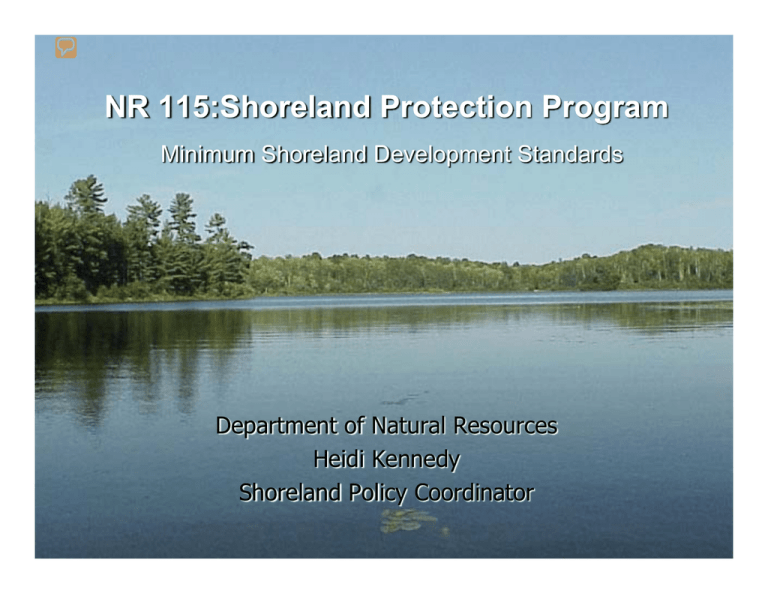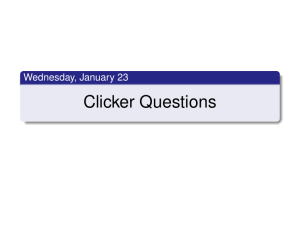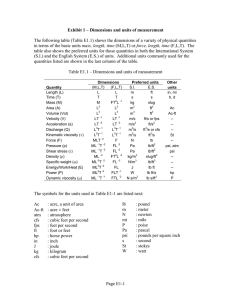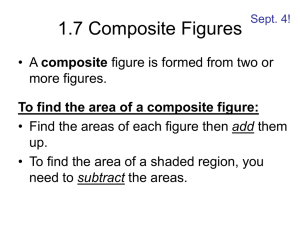NR 115:Shoreland Protection Program Minimum Shoreland Development Standards Department of Natural Resources
advertisement

NR 115:Shoreland Protection Program Minimum Shoreland Development Standards Department of Natural Resources Heidi Kennedy Shoreland Policy Coordinator Will this impact the growth of local economies? Old code not equipped for current development trends Higher Property Values = Human Amenities Diversity of Bugs, Fish, Wildlife Diversity & Variety of Habitat Water Quality NR 115 Shoreland Zoning Standards Goals of the new NR 115 What’s next? Counties must amend ordinance Buffalo County only one so far to amend ordinance DNR has reviewed 5 draft ordinances Brown, Dodge, Dunn, Jackson & Sawyer Over half of the counties have started drafting ordinance How can you get involved? County stakeholder or working groups Provide input through Lake Assoc./District County Planning and Zoning Committee meetings County Board meetings What are we looking at? The shoreland zone: 1000 feet inland of lakes 300 feet inland of rivers What has not changed? Setbacks Lot Size Unsewered lots = 20,000 ft2 100 ft average width Sewered lots = 10,000 ft2 65 ft average width Standards for Land Disturbing Activities 75-feet from the Ordinary High Water Mark Reduced setbacks (aka setback averaging) Structures exempt from Setbacks Shoreland-Wetland Standards Boathouses Open sided structures Antennas/satellite dishes Utilities Walkways, stairs or rail systems necessary for access Vegetative Buffer Zone 0-35 ft. from OHWM Removal allowed without a permit for: Routine maintenance Access/Viewing corridor Forestry activities Removal of exotics or invasives Other types of removal allowed with a permit. Vegetation removed with a permit must be replaced. Vegetative Buffer Zone: Key Terms Routine Maintenance of Vegetation = normally accepted horticultural practices that does not result in the loss of any layer of existing vegetation and does not require earth disturbance. Viewing or Access Corridor = combined width may not exceed 30 % of shoreline frontage or 200 feet. Impervious Surface Standards What is an impervious surface? Hard or solid surfaces that do not allow water to soak into the ground. Examples of impervious surfaces: Rooftops Sidewalks Driveways Parking lots Patios Height Restrictions 35 ft for residential structures County sets standards for commercial or other uses Non-conforming structures Maintenance – Expansion – 0-35 feet from OHWM– prohibited 35-75 feet from OHWM- vertical expansion only 75 feet + from OHWM – vertical or horizontal unlimited within existing building envelope Replacement/Relocation 0-35 feet from OHWM- prohibited Only if no other compliant location available All other non-conforming structures on lot removed Mitigation What might you have to do for a shoreland mitigation project? Each county identifies practices that are appropriate for local conditions Rain garden or other stormwater device Restore or maintain a vegetative buffer Remove a non-conforming accessory structure Paint home and other structures a neutral or earth tone color Reduce shoreland lighting Mitigation Required in NR 115 when: Performance Goals A property is increasing impervious surfaces above 15% A nonconforming structure is being vertically expanded, replaced or relocated Offset impacts to water quality, habitat & natural scenic beauty from proposed development County determines how to meet performance goals You can influence the shoreland zoning standards on your lake County can develop stricter standards than statewide minimums Lake classification Work with your county in development of: Impervious surface standards Height standards Non-conforming structure standards Mitigation Questions Existing Impervious Surfaces Impervious surfaces that existed prior to revision of the county shoreland zoning ordinance, may be: Maintained and repaired Replaced with a similar impervious surface within the existing building envelope Relocate or modify the impervious surface with a similar or different impervious surface if: No overall increase in % of impervious on the property Impervious surfaces meets the setbacks in NR 115. Impervious Surface Standards Applicable to: Land within 300 ft. of OHWM Standards No Permit needed if: Permit needed if: 0-15% of property is in impervious surfaces 15%-30% of property is in impervious surfaces Variance required for properties with over 30% impervious surfaces 30 ft. Garage 10’x22’ 220 ft2 75 ft. House: 32’ x 26’ = 832 ft2 Garage: 12’ x 20’ = 240 ft2 Driveway: 10’ x 40’ = 400 ft2 Total = 1472 ft2 House 32’x26’ 832 ft2 35 ft. 10,000 ft2 lot: 15%: 1,500 ft2 Driveway 10’x 40’ 423 ft2 154 ft. 15% IS when lot size is 10,000 sq. ft. Drawing more or less to scale ~ ~ ~ Lake ~ ~ ~ 65 ft. (Lot area: 10,010 sq. ft.) Drawing more or less to scale Garage 20’x24’ = 480 ft2 House 30’x 50’ 35 ft. 1,500 ft2 75 ft. House: 30’ x 50’ = 1,500ft2 Garage: 20’ x 24’ = 480 ft2 Driveway: 10’ x 95’ = 950ft2 Total = 2930 ft2 200 ft. 20,000 ft2 lot: 15%: 3,000 ft2 Driveway: 10’x 95’= 950 ft2 15% IS when lot size is 20,000 sq. ft. 30 ft. ~ ~ ~ ~ ~ Lake ~ ~ ~ ~ ~ 100 ft. (Lot area: 20,000 sq. ft.) Drawing more or less to scale 30% IS when lot size is 10,000 sq. ft. Driveway: 10’x 40’= 400 ft2 Garage 20’x 24’ = 480 ft2 10,000 ft2 lot: 30%: 3,000 ft2 House 1,500 ft2 35 ft. Boathouse 20’ X 12’ = 240 ft2 75 ft. House: 30’ x 50’ = 1500 ft2 Garage: 20’ x 24’ = 480 ft2 Driveway: 10’ x 40’ = 400 ft2 Boathouse: 20’ x 12’ = 240 ft2 Total = 2620 ft2 154 ft. 30’x 50’ ~ ~ ~ Lake ~ ~ ~ 65 ft. (Lot area: 10,010 sq. ft.) Drawing more or less to scale 30% IS when lot size is 20,000 sq. ft. Drive: 12’x 85’= 1020 ft2 Accessory building 30’ x 36’ 1080 ft2 Garage 40’x 30’ = 1200 ft2 40’x 50’ 2,000 ft2 35 ft. Boathouse 30’ x 20’ 600 ft2 ~ ~ ~ Lake ~ ~ ~ 100 ft. (Lot area: 20,000 sq. ft.) 75 ft. House: 40’ x 50’ = 2000 ft2 Garage: 40’ x 30’ = 1200 ft2 Driveway: 12’ x 85’ = 1020 ft2 Boathouse: 30’ x 20’ = 600 ft2 Accessory bldg.: 30’ x 36’ = 1080 ft2 Total = 5900 ft2 House 200 ft. 20,000 ft2 lot: 30%: 6,000 ft2







